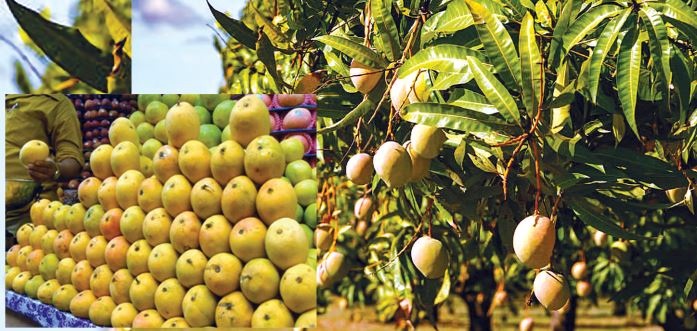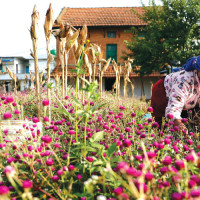- Sunday, 19 October 2025
Time For Juicy Mangoes
Ram Dayal Rakesh
Tropical Fruit
It is said in the Maithili language that these valuable enchanting eateries are not available in heaven. Nobel Laureate poet Rabindra Nath Tagore's love affair with mangoes is known all over the world. According to him, provided he failed to receive many auspicious occasions to taste any mango in that year he thought that year to be fruitless. Mango is one of the most popular tropical fruits in the world and has been cultivated in Terai-Madhesh of Nepal and also in neighbouring countries India, Bangladesh, Pakistan, Sri Lanka, Cambodia, Burma(Myanmar) and Taiwan. Even one can get mango in Honolulu (U.S.A).
Credit goes to the Buddhist monks who introduced it to Malaysia and eastern Asia around the 5th century. According to one recent study, almost half of the world's mangoes are grown in India itself. It produces about 15 million tonnes of mangoes, with 15.3% exported to foreign countries and the rest consumed domestically.
In the cultural domain of Mithilanchal, the importance of mango has been recognised since time immemorial. There are mango orchards in every village of the Mithila region. Janakpur, the capital of ancient Mithila has been famous for mango orchards since the creation of the universe. There is still historically culturally and religiously myth- logically famous mango orchard in Janakpur called Tirhutia Gachhi(the Mango tree of Tirhut). Every year Mithila Mahotsav (Mega festival of Mithila) is observed in this orchard. It is also believed that Lord Buddha, the Light of Asia stayed in this orchard when he visited Janakpur.
The exchange of mangoes during the mango season is considered to be the best gift. For a newly married couple, it is considered a heavenly gift. Even if gold, silver and diamonds were gifted, they would be deemed worthless if mangoes were not presented. Even before or after the wedding ceremony, if mangoes are not exchanged as gifts during the mango season it would mark the merriment and mirth of the marital life of the couple. These incomparable gifts play a pivotal role in bridging a cordial relationship between two families.
Summertime and rainy season are suitable for mangoes. They are beautiful, succulent and sumptuous. There are many delicious delicacies of mangoes such as mango flame, mango tart, mango scone, mango and celery muffin, mango crumble and fresh-cut mango in a chocolate cone with mango mousse. Mangoes are very sweet, fragrant and tasteful. They are luscious, succulent, juicy and tasty. They are called kings of fruits. This is deeply rooted in the cultural heritage of Mithila.
Varieties
The climate of the Madhesh region is tropical. So, it is a very suitable climate for mango growing. Several varieties of mangoes are grown in the fertile soil of Madhesh. Most of them are big, but some of them are small also. Big ones are called Bombaiya, Maldah, Calcutiya, Supriya and Amrapalika, and small ones are called Bizzu. They all are sweet and beautiful to look at. There is a different type of it which is called Bhadaiya which becomes ready to eat in the month of Bhadra (august-Sept).
There is still another variety which is called Langada which cannot be translated into any language in the world. Some of the Bijju mangoes are very juicy. They are called senuria (its colour is like vermilion) and keraba (its size is like a banana). Mangoes such as the Tengaria, Sukul, Sipia, Kodaiya, Nakuwa, Laduwa, Lichiawa (like lichhi), Chauriya, Bairiya and Rodi are seasonal.
But one variety of mangoes available throughout the year is called the Barmasiya. Mangoes are generally available from Jestha(June) to Bhadra(August). Fresh mangoes used to be available for three months only, but nowadays they are in the market for more than six months, because they are preserved in cold storage. They come in round, oval, oblong or somewhat kidney-shaped forms. I would like to quote a different variety of mango:
"The variety of mangoes including Sindhuri, Dusseri, Chausa, Fazli, Lucknowa, Jauhari, Gulab Khaas and Langra are cultivated in the northern Indian state of Uttar Pradesh, South India for a mind-boggling choice too. Raspuri, Safeda (Bainganpalli, Neelam, Himayat, Thamboor Priyoor, Malgova and Malika, each with distinct colour and taste, Kesar, known for its unique sweetness and long shelf life, is grown in Gujarat and Maharastra." (Jahnavi Sarma: An Indian affair for life. India Perspective. Vol.28, Sept- October 2014)
Then there are regional specialities like Maharastra's amrakhand (mango shrikhand) which combines whipped mango pulp with sweet yoghurt. In north India, mangoes are thinly sliced and sun-dried to make a preserve called Muraba.
Mango-flavoured Sambhar(lentil-based gravy dish with tamarind) in south India and a tangy mango-flavoured Dal(lentils curry) in north India are delicacies made during summer. Amras, juice made of mango pulp with sugar or milk, goes with bread, rice or pooris( fried bread) in Gujarat, Maharashtra and Rajasthan. Rice mango pulp is used to make a Jam called mangada by the Konkanis in west India. Mango is used in Andhra Pradesh to make Dal while Gujaratis use it to make Chunda(grated mango delicacy).
Mango lassi( mango blended in yoghurt) is a drink of choice for most Indians as well as South Asians.
That's why they are served on occasions such as marriage ceremonies, various rites and rituals and folk festivals. They are considered sacred too. For this reason, they are offered to different gods and goddesses. They also solve the food problem to some extent in the Madhesh region during the growing season. Being highly digestible and nutritious, they are often prescribed for good health because they contain vitamins A, B and C.
The unripe mangoes are also useful and tasteful. Different types of chutneys and pickles are also made from them. Ripe mangoes are used in making Amot(a homemade foodstuff) and it is used the whole year. Mangoes are of different colours. They are yellow, pink, green and red and in a variety of hues in-between the size of the smallest mango is 15 inches(3.75 centimetres) long, while the largest is 8 inches.
Ideal Climate
Mithila feels pride in having 200 varieties of mango. The mango tree can be small as well as big. It is known as the Mangifera Indica. It grows better in hot, humid and dry weather. The Mithila region has an ideal climate for its good cultivation. The fruit becomes tasty and juicy when the air is dry. The pleasure of sucking mangoes is more enjoyable than eating them. Maithil people love to suck its fresh juice from the freshly plucked fruit.
(The author writes about Terai issues)

















